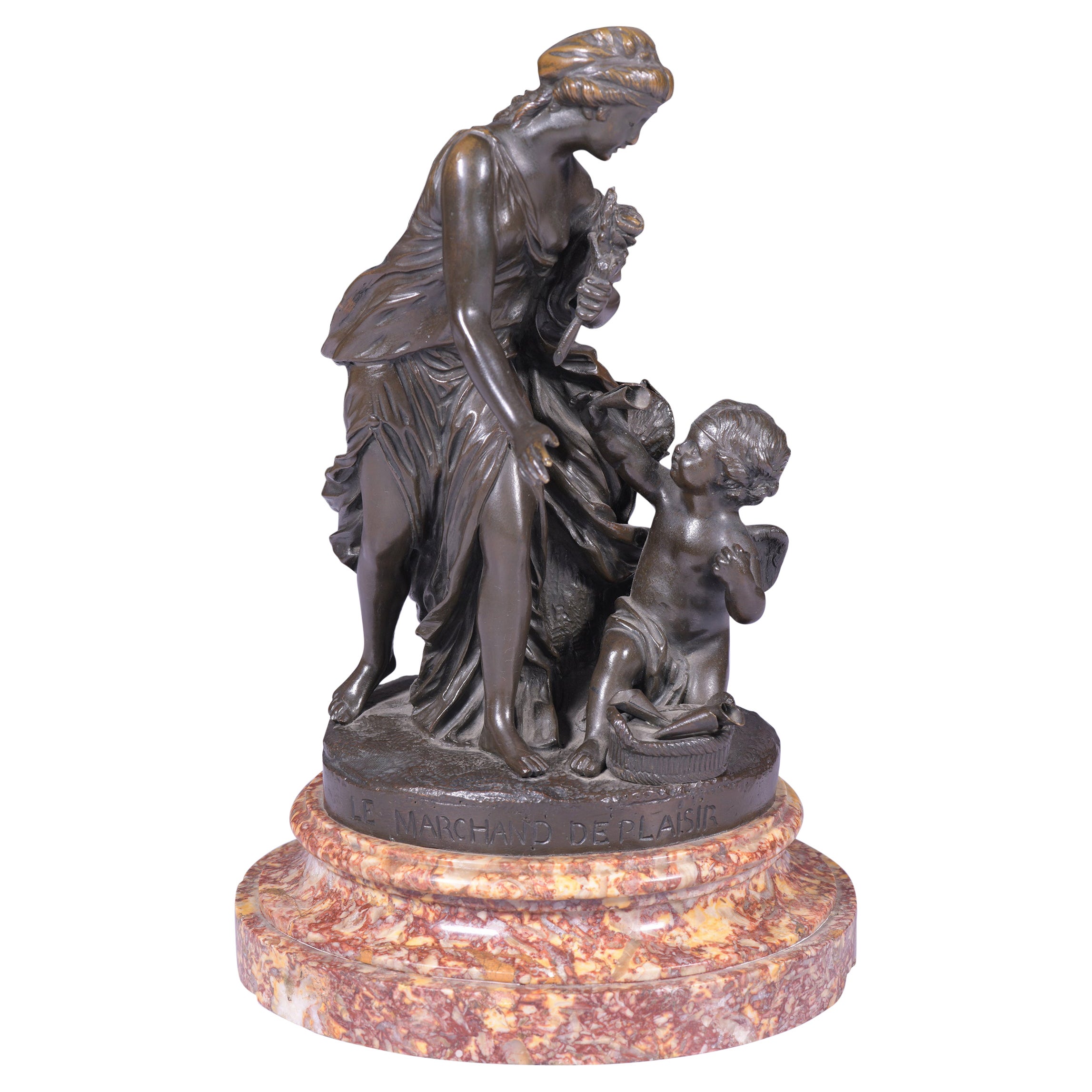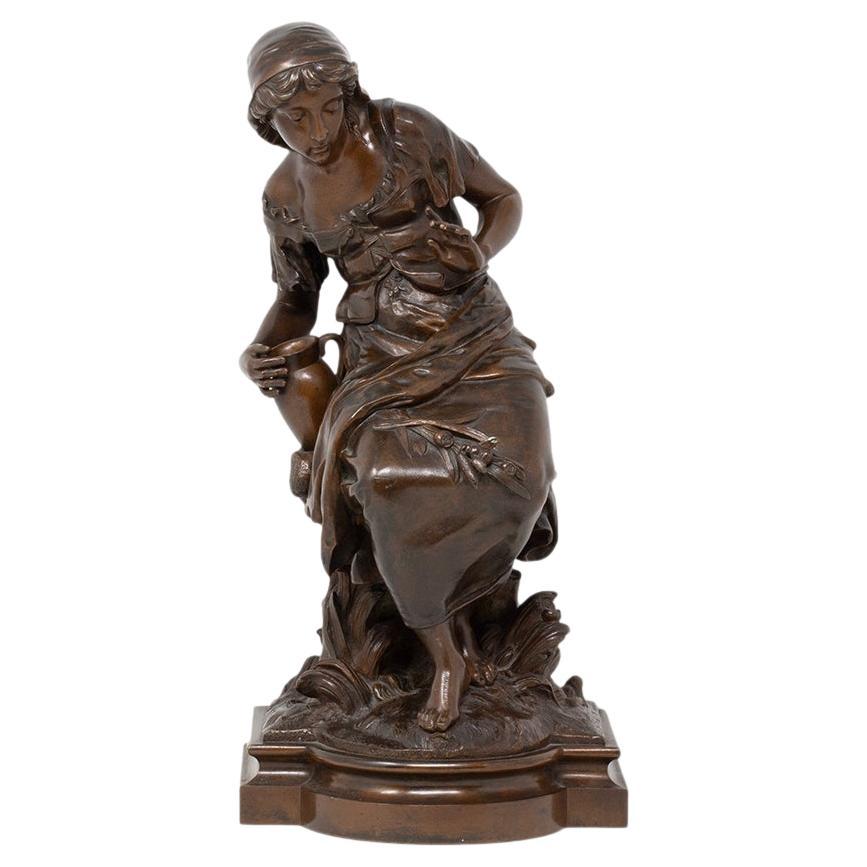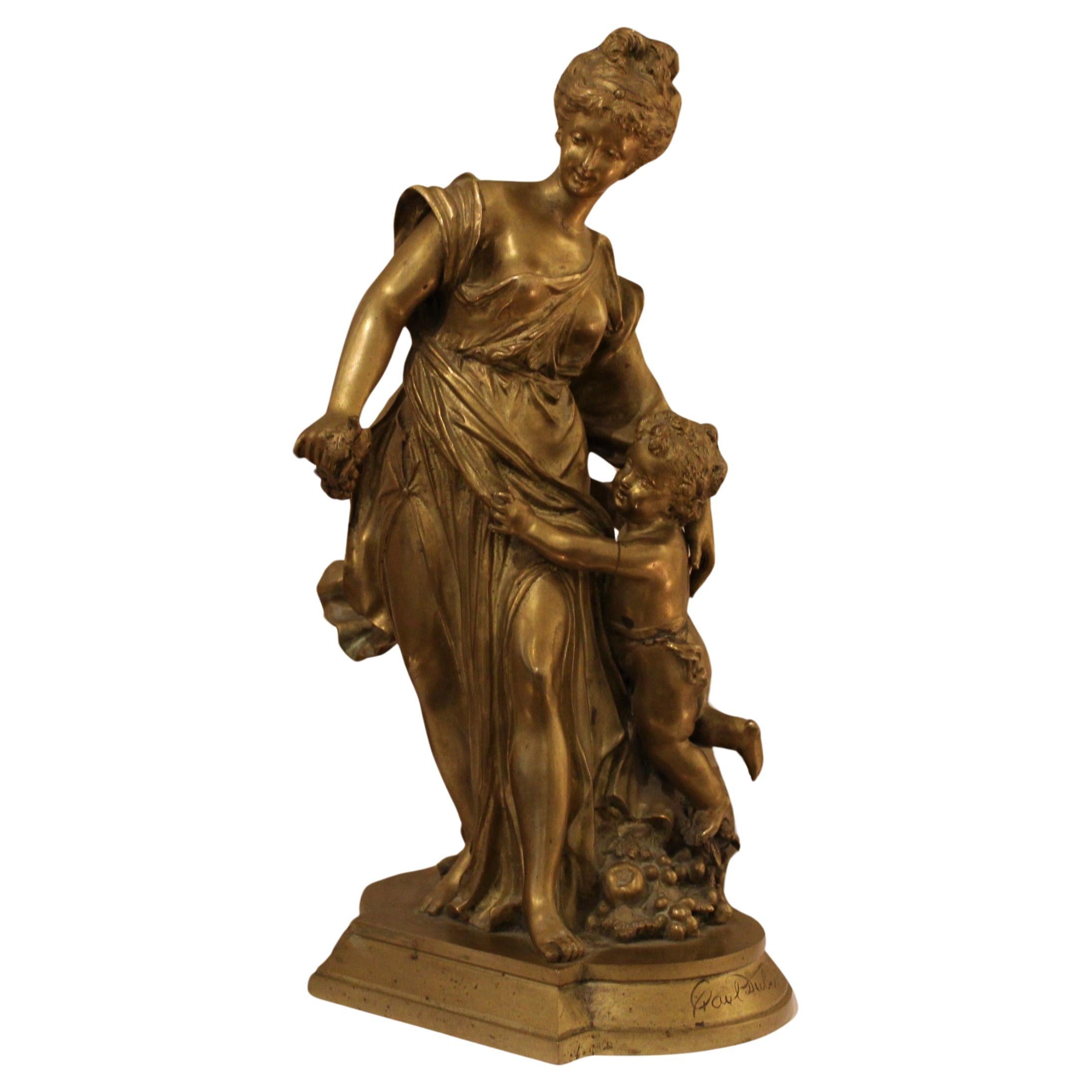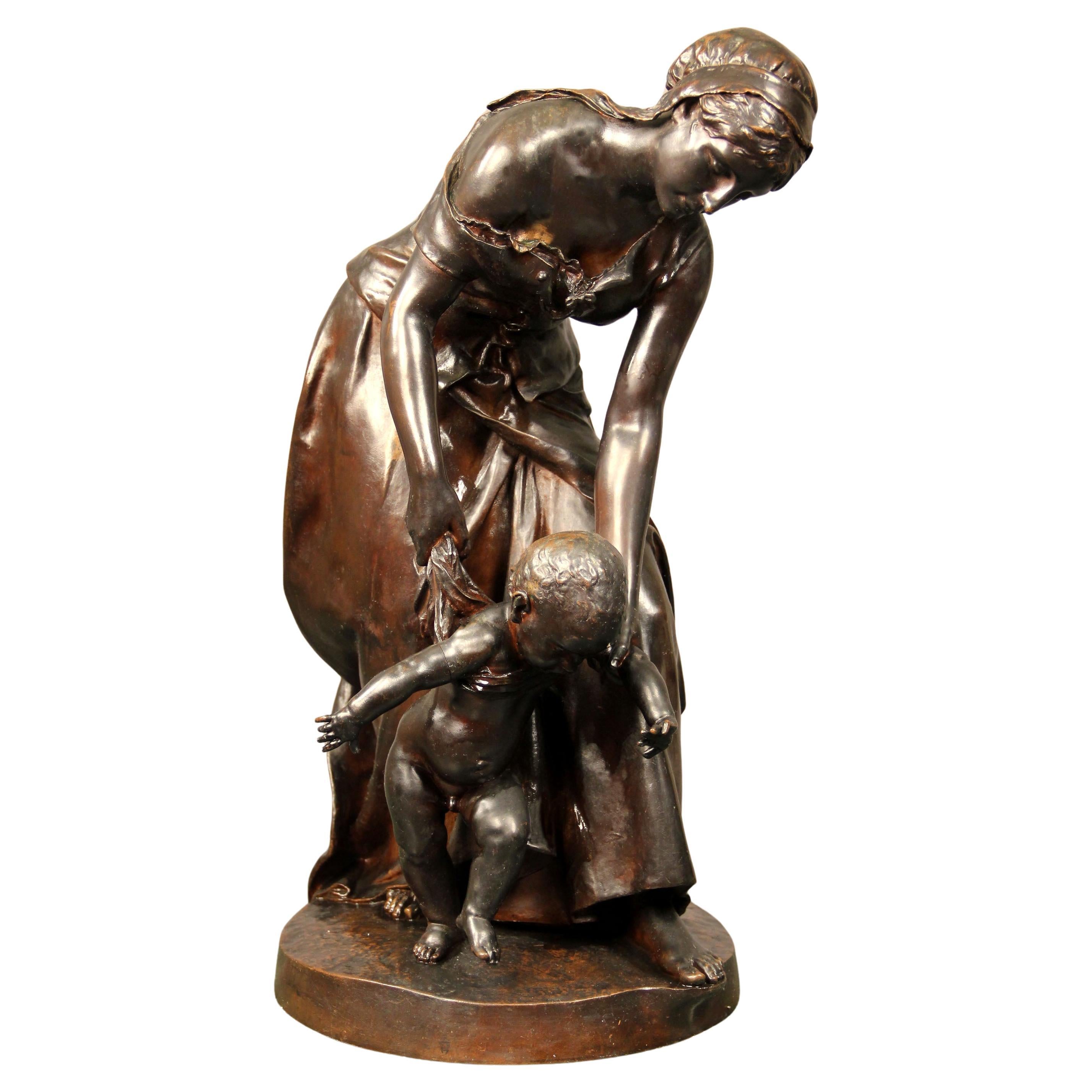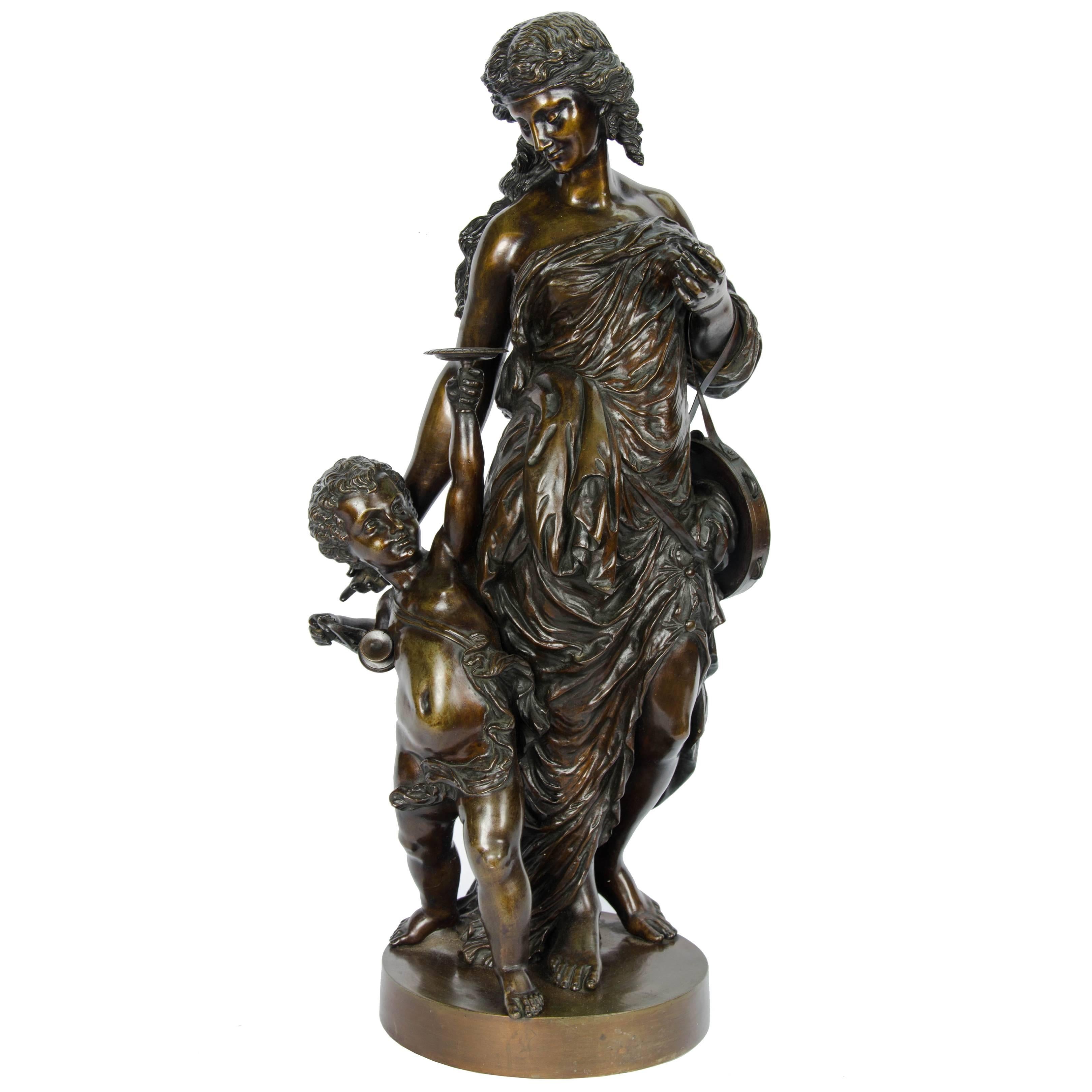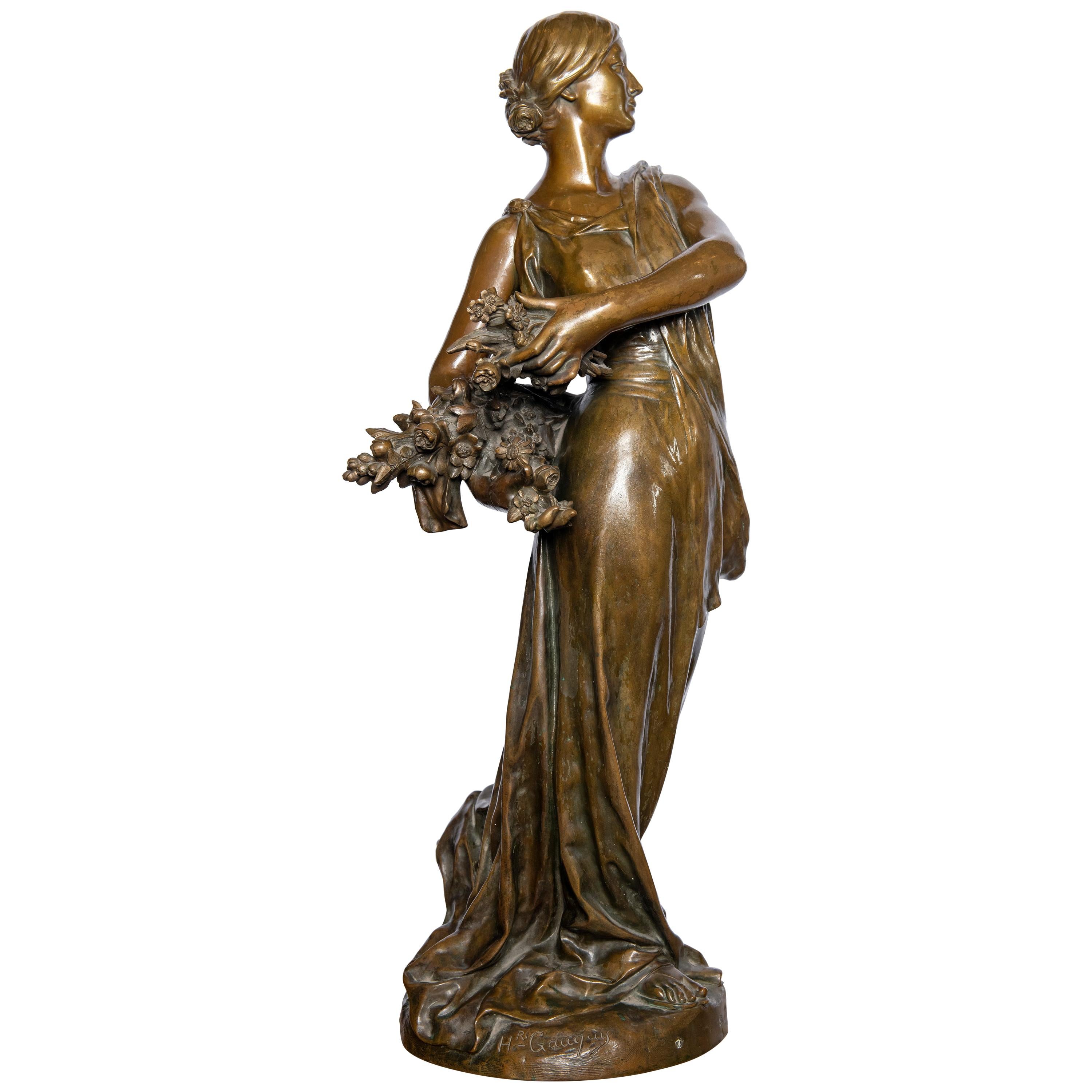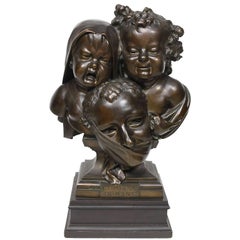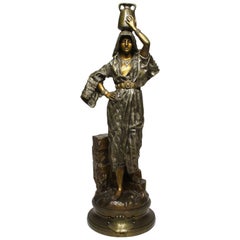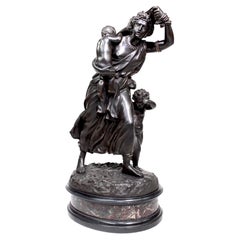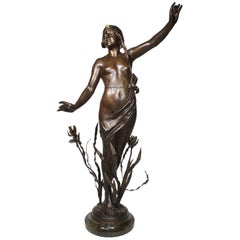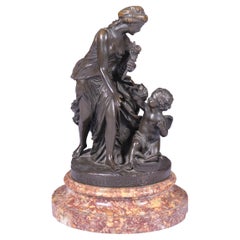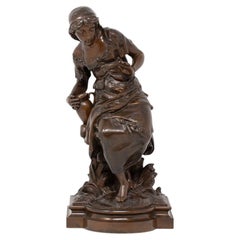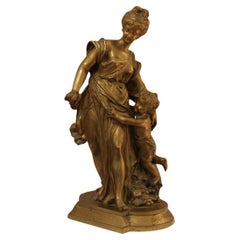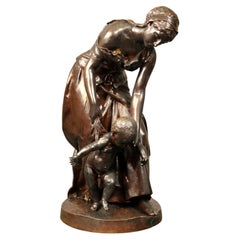Items Similar to A French 19th Century Bronze Sculpture Titled "La Sécurité" Eugène Delaplanche
Video Loading
Want more images or videos?
Request additional images or videos from the seller
1 of 11
A French 19th Century Bronze Sculpture Titled "La Sécurité" Eugène Delaplanche
$18,450
$35,00047% Off
£14,305.58
£27,137.9647% Off
€16,232.37
€30,793.1147% Off
CA$26,447.28
CA$50,17147% Off
A$28,757.65
A$54,553.8147% Off
CHF 15,152.48
CHF 28,744.5347% Off
MX$349,322.04
MX$662,670.5447% Off
NOK 190,497.21
NOK 361,376.8247% Off
SEK 178,575.75
SEK 338,761.5847% Off
DKK 121,809.74
DKK 231,075.3947% Off
About the Item
A very fine French 19th century brown and parcel-gilt patinated bronze sculpture titled "La Sécurité" (The Security - Protection) after a model by Eugène Delaplanche (French, 1836–1891). Depicting a sitting young Maiden in a gilt-decorated armored suit and helmet, a lion skin on her back, holding a resting child on her arm. Raised on Rouge-Royal marble plinth inscribed "La Sécurité - Par E. Delaplanche - Salon des Beaux-Arts de Paris". Signed: E. Delaplanche and stamped with the importer's seal - Alberto Vignes y Ca - Buenos Aires, circa 1890.
Measures: Height: 28 3/4 inches (60.3 cm).
Width: 16 inches (40.7 cm).
Depth: 14 inches (35.6 cm).
Eugène Delaplanche (February 28, 1836 – January 10, 1891) was a French sculptor, born at Belleville (Seine).
He was a pupil of Duret, gained the Prix de Rome in 1864 (spending 1864-67 at the Villa Medici in Rome) and the medal of honor in 1878. His "Messenger of Love" (1874), "Aurora" (1878), and the "Virgin of the Lillies" (1884), are in the Luxembourg. Other works by him are "Music - La Musique" (1878, Paris Opera House), called his masterpiece; "Eve After the Fall" (1869); "Maternal Instruction" (1875, Square of Sainte-Clothilde, Paris). He is also noted for his decorations in relief on vases of Haviland faience. His best work is naturalistic, but at the same time dignified and simple in line and shows sound mastery of technique. He is represented by 15 works in the Glyptothek, Copenhagen and in many other French museums and in churches.
This sculpture of La Sécurité is after his 1884 sculptures of "Security and Commerce" in the Hôtel de Ville, Paris (replicas in the Chicago Art Institute).
Museums and works:
Musée d'Orsay, Paris.
Virgin with a lily, marble.
Africa, 1878, bronze, on the parvis of the museum.
Eve before the Fall, 1869, marble.
Eve after the Fall, circa 1891, marble.
Musée des Beaux-Arts, Marseille.
Child riding a tortoise, 1866, bronze.
Musée Antoine Vivenel.
Allegory of Air, bronze, Compiègne.
Allegory of Water, bronze, Compiègne.
Musée Crozatier.
Study of a monk's head, circa 1870, marble, Le Puy-en-Velay.
Paulhan in Hérault.
Saint Agnes, 1873, Église Sainte-Croix.
Square Samuel-Rousseau, 7th arrondissement, Paris.
Maternal education, 1875.
- Attributed to:Eugène Delaplanche (Sculptor)
- Dimensions:Height: 28.75 in (73.03 cm)Width: 16 in (40.64 cm)Depth: 14 in (35.56 cm)
- Style:Belle Époque (In the Style Of)
- Materials and Techniques:
- Place of Origin:
- Period:
- Date of Manufacture:circa 1890
- Condition:Wear consistent with age and use. Minor fading. In very condition with minor wear and rubbing consistent with age and use.
- Seller Location:Los Angeles, CA
- Reference Number:Seller: Ref.: A17361stDibs: LU179624105933
About the Seller
5.0
Vetted Professional Seller
Every seller passes strict standards for authenticity and reliability
Established in 1982
1stDibs seller since 2016
136 sales on 1stDibs
Typical response time: 1 hour
- ShippingRetrieving quote...Shipping from: Los Angeles, CA
- Return Policy
Authenticity Guarantee
In the unlikely event there’s an issue with an item’s authenticity, contact us within 1 year for a full refund. DetailsMoney-Back Guarantee
If your item is not as described, is damaged in transit, or does not arrive, contact us within 7 days for a full refund. Details24-Hour Cancellation
You have a 24-hour grace period in which to reconsider your purchase, with no questions asked.Vetted Professional Sellers
Our world-class sellers must adhere to strict standards for service and quality, maintaining the integrity of our listings.Price-Match Guarantee
If you find that a seller listed the same item for a lower price elsewhere, we’ll match it.Trusted Global Delivery
Our best-in-class carrier network provides specialized shipping options worldwide, including custom delivery.More From This Seller
View AllFrench 19th Century Patinated Bronze "Comedia Humana" after Jean Barnabé Amy
By Jean Barnabé Amy
Located in Los Angeles, CA
Jean Barnabé Amy (French, 1839-1907) a fine French 19th century dark-brown patinated bronze group titled "Comedia Humana" (Human Comedy - Comedie Huma...
Category
Antique Late 19th Century French Greco Roman Figurative Sculptures
Materials
Bronze
$4,985 Sale Price
22% Off
After Gaston Leroux French 19th Century Bronze Sculpture of Rebecca
By Gaston Veuvenot Leroux
Located in Los Angeles, CA
A fine French 19th-20th century orientalist silvered and gilt patinated bronze sculpture of "Rebecca" with a plaque that reads "Jeune Fille Arabe" (A Young Arab Girl - Water-Carrier)...
Category
Antique Early 1900s French Greco Roman Figurative Sculptures
Materials
Bronze
$6,985 Sale Price
26% Off
An Italian Cast 19th Century Bronze Group Mother & Children Titled "La Tempête"
By Mathurin Moreau
Located in Los Angeles, CA
A Fine Italian Cast 19th Century Bronze Group Titled "La Tempête" (The Tempest) Probably after Mathurin Moreau (French, 1822–1912), Cast by The Alessandro Nelli Foundry in Rome. The ...
Category
Antique Early 1900s Italian Classical Roman Figurative Sculptures
Materials
Marble, Bronze
$15,160 Sale Price
20% Off
French Art-deco-orientalist Spelter of a Nude Young Maiden, Attributed to Hottot
By Louis Hottot
Located in Los Angeles, CA
An Imposing fine and large French Art-Deco Spelter (Petit-bronze) figure of a standing semi-nude orientalist maiden in a brown patina, attributed to Louis Hottot (French, 1834-1905). The smiling young topless beauty, posing with her arms outstretched, her hair wrapped with a headscarf centred with a green art-glass bead and a scantily scarf tied around her waist, standing barefoot among tropical shrubs and flowers and raised on a circular mottled green marble base. A brass plaque reads "TYPHA", Paris, circa 1900.
Louis Hottot was a French sculpture who mainly specialized in Orientalist female figures and other Orientalist subjects and themes, most of his works were produced in spelter. He exhibited his works at the Paris Salon from 1885 to 1898. Hottot is best known for his Orientalist-themed sculptures, including Almie du Caire, circa 1887 and Fille d'Egypte, circa: 1885. He was a member of the Socie´te´ des Artistes Franc¸ais.
Literature:
Les Bronzes du XIXe Siecle, P. Kjellberg, Les Editions de L'amateur, Paris.
S. Richemond, Les Orientalistes...
Category
Antique Early 1900s French Art Deco Figurative Sculptures
Materials
Marble, Spelter
$24,850 Sale Price
29% Off
Gaston Leroux Bronze Figure of Aida on a Sphinx, French, 19th Century
By Gaston Vuevenot Leroux
Located in Los Angeles, CA
Gaston Leroux (French, 1854-1942). A very fine French 19th century polychromed and patinated bronze sculpture of "Aida" resting on a sphinx, her legs crossed and holding a gilt-bronze tambourine, after the model by Gaston Veuvenot Leroux "Aida, A Femme Au Tambourin Assise Sur Une Tete De Sphinx". Signed: Gaston Leroux, Paris, circa 1890.
Measures: Height 29 inches (74 cm).
Width 15 inches (38.1 cm).
Depth 15 inches (38.1 cm).
The opulent and extensively detailed version of Aida was inspired by ethnographic findings of the mid-19th century in ancient Egypt as well as the influences of theatre and costume design. Travelers to the East had often recorded their journeys, either in writing or in pictures, but the movement of Egyptomania was wider-reaching than Egyptology. The immensely popular vogue of Egyptomania is without doubt due to the success of performing arts in recreating this era, in particular, Giuseppe Verdi's Aida. Both the Cairo and Paris premieres created sensations so large that they influenced generations of artists from Alexander Cabanel to Cecil de Mille. In Aida, the ruins of Egypt were brought back to life in full color and scale before the eyes of a generation that would make history as romantics, adventurers and explorers.
The Cairo premier of Aida was entirely conceived by one of the foremost Egyptologists of the day, Auguste Mariette, who was assigned to the project by Khedive Ismail Pasha...
Category
Antique Late 19th Century French Egyptian Revival Figurative Sculptures
Materials
Bronze
$26,950 Sale Price
23% Off
Lifesize French 19th-20th Century Carved Marble Sculpture of "Venus and Cupid"
By Félix Charpentier
Located in Los Angeles, CA
A lifesize French 19th-20th century carved marble sculpture of "Venus and Cupid" In the manner of Felix Maurice Charpentier (French, 1858-1924). The tall and slender nude figure of a...
Category
Antique Early 1900s French Greco Roman Figurative Sculptures
Materials
Marble
You May Also Like
19th Century French Classical Bronze Group Signed Pigal "Le Merchand De Plaisir"
Located in Dublin, IE
A superb bronze model of a classical maiden and a putto entitled 'Le Merchand de Plaisir' the winged putto holding a posey vase, the maiden with a rose, on ...
Category
Antique 19th Century French Neoclassical Figurative Sculptures
Materials
Marble, Bronze
French Antique Bronze Sculpture by Eutrope Bouret
By Eutrope Bouret
Located in Newark, England
Lady and the Bee
From our Bronze Sculpture collection, we are delighted to offer this beautiful French Bronze Sculpture by Eutrope Bouret. The Sculpture modelled in bronze with a su...
Category
Antique Late 19th Century French Belle Époque Figurative Sculptures
Materials
Bronze
Bronze sculpture, by Paul Duboy (1830-1887) France, 19th century
By Paul Duboy
Located in Paris, FR
Gilted bronze sculpture of a young woman by Paul Duboy (1830-1887)
France, 19th century
Signed on the side PAUL DUBOY
Category
Antique Mid-19th Century French Figurative Sculptures
Materials
Bronze
A Late 19th Century Bronze Sculpture Entitled “Les Premiers Pas” by Henri Plé
By Henri Honoré Plé, F. Barbedienne Foundry
Located in Long Island City, NY
A Nice Late 19th Century Bronze Sculpture Entitled “Les Premiers Pas” (First Steps) by Henri Plé
Henri Plé and Ferdinand Barbedienne
Depicting a mother helping her baby learn how t...
Category
Antique Late 19th Century French Belle Époque Figurative Sculptures
Materials
Bronze
Large classical 19th Century Bronze Statue
Located in Brighton, Sussex
A very good quality classical Italian bronze statue of a mother and child.
Category
Antique 1860s Italian Figurative Sculptures
Materials
Bronze
Bronze Sculpture Signed H. Gauquie, France, Late 19th Century
By Henri Desire Gauquie
Located in Buenos Aires, Buenos Aires
Bronze sculpture signed H. Gauquie, France, late 19th century.
Category
Antique Late 19th Century French Art Nouveau Figurative Sculptures
Materials
Bronze
$11,200 Sale Price
20% Off
More Ways To Browse
Eugene Used Furniture
La Belle Antique
Hotel De Paris
Antique Haviland
Armor Helmet
Paris Opera House
Church Sculpture
Antique Armor Suits
Monk Head
Paris Lily
Eugene Delaplanche
Bas Relief Marble
Black Jockey
Blue Head Sculpture
Book Shelf Table
Brass Dancer Sculpture
Bronze Archer Sculpture
Bronze Erotic Sculpture
